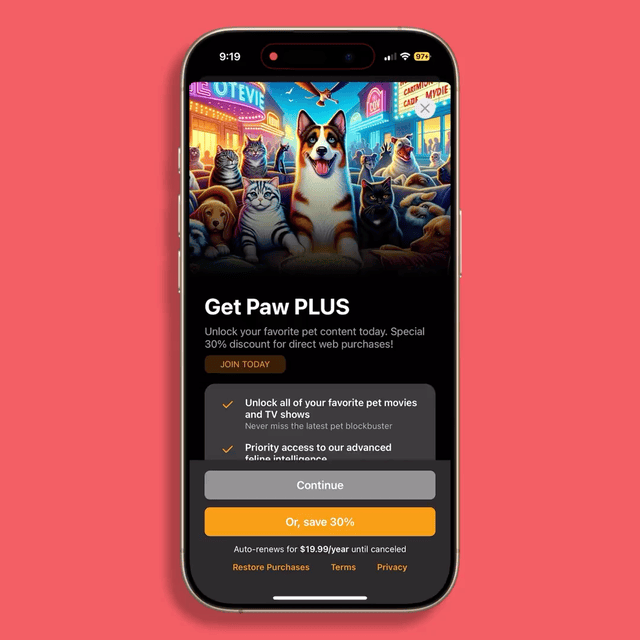The rules of the App Store have changed!
I’m sure you’ve heard the news: a US judge has ruled that Apple must allow app developers to use third-party payment systems!
This is a really big change for the app ecosystem, so how about we go over it and see what are the opportunities (and the risks!) for developers?
Advertisement
RevenueCat makes adding subscriptions to your app simple🚀
Never worry about StoreKit 🤦♂️📱
Plus, get out-of-the-box charts and reporting for your app 📈📊
Sponsors like RevenueCat really help me grow my content creation, so if you have time please make sure to check out their product: it’s a direct support to my content creation ☺️
Let’s start by recapping what happened.
On April 30th, a US judge found Apple to be in violation of a 2021 injunction to stop anticompetitive practices on the App Store.
In addition, the judge ordered Apple to immediately allow developers to include links to external payment systems for in-app purchases.
(if you want, you can actually read the 80-page ruling document!)
The next day, Apple updated its App Store guidelines to comply with the ruling.
Here are the updated rules:
3.1.1(a): On the United States storefront, there is no prohibition on an app including buttons, external links, or other calls to action, and no entitlement is required to do so.
3.1.3: The prohibition on encouraging users to use a purchasing method other than in-app purchase does not apply on the United States storefront.
3.1.3(a): The External Link Account entitlement is not required for apps on the United States storefront to include buttons, external links, or other calls to action.
Now let’s talk about what this means for app developers.
First, as stated in the updated App Store guidelines, this new freedom currently only applies to apps sold in the US App Store.
(although we can definitely expect other geographies, like the EU, to soon start imposing the same obligations)
Basically, your paywall can now redirect to an external payment platform (like Stripe), in addition to Apple’s own in-app purchase system.
And, of course, all purchases made through an external platform are not subject to Apple’s 30% fee!
Moreover, Apple is now only allowed to show a small warning to inform users that they are leaving the App Store ecosystem.
When you compare it with the large scary warning that they used to display for the few apps that were already allowed to redirect to external payment platforms, the difference is quite striking:
However, it’s important to be aware that using an external payment platform also comes with a flip side!
Indeed, when not using Apple’s in-app purchases, the developer must take on additional responsibilities.
Some of them, like implementing user management, shouldn’t be too hard to handle.
But others, like collecting VAT in each country where the app is available can be much more challenging, because they are very time consuming and they fall outside the area of expertise of a typical app developer.
Of course, it’s possible to use an external payment provider that also acts as a Merchant of Record and that will handle these responsibilities.
But they will likely do so in exchange for a higher fee…
It’s also worth noting that, with some exceptions, apps are only allowed to offer an external payment provider as an alternative: the purchase has to stay possible using Apple’s in-app purchases.
(However, there’s no requirement to show both options with the same level of prominence in your UI…)
Finally, let’s talk about what you should do as an app developer
If you’re a strong, well established app developer, with a mature product, then this is definitely a big opportunity to grow your revenue!
When you have the resources to handle the responsibilities that come with opting-out of Apple’s in-app purchases, going from a 30% fee to a much lower one has the potential to tremendously boost your revenue!
(it’s no coincidence that the driving forces behind this legal battle are big actors like Epic or Spotify: they’re the ones that stand to gain the most!)
There’s just one thing to be mindful of: maybe Apple will be less likely to offer App Store featuring to apps that opt-out of their payment system…
On the other hand, if you’re an indie developer working on your app with a small team (or even solo), the situation is quite different!
Opting-out of Apple’s in-app purchases means handling a lot of new responsibilities: is it really worth the defocus from your actual product?
Additionally, it’s important to remember that Apple’s payment system is a very convenient high-trust low-friction process for your users:
just double-tap a button, no need to input payment card details
subscriptions can be cancelled easy, low fear of being scammed
This is especially true for small apps, for which users are very likely to drop out if the payment process requires too much effort or starts to feel risky.
If the added friction ends up decreasing your conversion too much, it might actually negate what you’ve gained from a reduced payment fee.
Overall, if you qualify for Apple’s small business program, where Apple’s fee is already reduced to 15%, it really might not be worth opting-out.
So what should you do?
The smart move is to run a test and see how your users actually react!
And if you want to run that test with minimal effort, you’ll want to look at what RevenueCat has to offer.
Because in the hours that followed the ruling, they actually shipped a new feature that allows their paywalls to redirect to a web checkout:
And through a clever combination of Apple Pay and deep linking, it even manages to offer a checkout experience that is quite smooth:
If you want to give it a try, check-out this page which contains all the step to configure and run your experiment 😌



